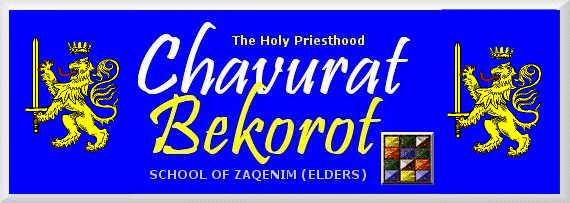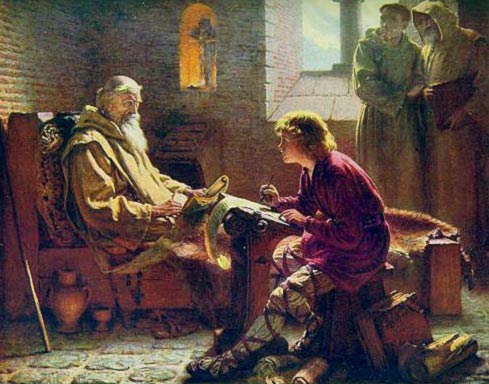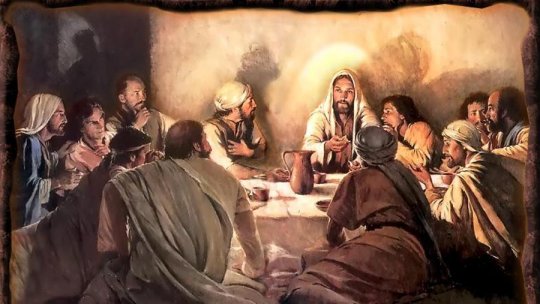
 9
JOHANNINE ESSAYS
9
JOHANNINE ESSAYS
 The Theology of the Last Supper
(15 November 1982)
The Theology of the Last Supper
(15 November 1982)
by Christopher C. Warren, M.A.(Oxon)

Intro | 1 | 2 | 3 | 4 | 5 | 6 | 7 | 8 | 9 | 10 | 11
12 | 13 | 14 | 15 | 16 | 17 | 18 | 19 | 20 | 21
The account of the last supper in John's gospel differs substantially from the Synoptics in emphasis. John concentrates on the washing of the disciples' feet, an ordinance that interrupts the supper, whilst the Synoptics pay more attention to the inauguration and symbolic significance of the Eucharist.
The washing of the disciples' feet is a sign that John understands in more than one way theologically, and he makes it clear to his readers that this is so. First, he makes Yah'shua (Jesus) say that what he has done is an example for His disciples to follow; they are to be servants (shammashim, Deacons) to one another, just as Yah'shua (Jesus) has acted as servant (shammash, Deacon) to them. But secondly, washing suggests something other than simply the work of a servant: washing means cleansing, and it reminds the believer of his baptism; and to be baptised is to enter into the benefits of Christ's death and resurrection. So the washing stands for the whole mission of Yah'shua (Jesus), and just as the purpose of His mission is to associate Himself with people, and vice versa, in a fellowship, so Yah'shua (Jesus) says that if He does not wash them, they will not be partners with Him. However (and this is the third element in the understanding of this sign), neither washing, nor the death and resurrection of which it is a symbol, can be effective without faith and love on the part of the disciples; so John reminds us that Judas was present and was washed, but was not clean.
These three elements in the understsanding of this sign are connected with one another, and are not alternative interpretations of it, or separable from one another. The purpose of the mission of Yah'shua (Jesus) is to create a fellowship of love among men which exists because of the love of Yah'shua (Jesus) for them; the cleansing of which He speaks is cleansing from everything that contradicts love, and all this within the context of Torah. The only kind of impurity which is recognised by this fellowship is selfishness, represented here by Judas. The foot-washing is firstly a symbol of the passion, and secondly an example for the disciple: the purpose of the passion and the substance of discipleship are identical.

It is odd that the emblems of the Eucharist are not directly stressed in John's account but they are nevertheless implied. There are only two emblems involved - bread and wine - which correspond, respectively, to Christ's body and blood which will be shed for them. We see in the Eucharist a simplification of the Pesach (Passover) Meal whose elements were designed to remind the Israelites of their miraculous escape and deliverance from Egypt. Now, in addition, and primarily, the believer is required to remember Christ through the emblems which embrace far greater theological concepts than the Passover ever did. Yah'shua (Jesus) is the centre of everything, including Israel's miraculous escape from Egypt, but now the attention is on His atoning sacrifice and the ability to be cleansed by Him. The bread and the wine were designed to focus the attention of the partaker on Christ's redemptive work - eating the bread symbolising partaking of the divine nature, and drinking the wine in participating in His spiritual healing. The wine emblem is fitting on two accounts: (1) its colour reminds one of blood, and (2) its taste no doubt was intended to parallel the drinking of bitter herbs on the Passover; the bitterness of the Israelites is now transferred to the bitterness and suffering Christ had to endure to perform His vicarious sacrifice.
Yah'shua (Jesus) gives substantial instruction during the last supper. His emphasis is again on love by which He declares that the disciples will be known apart from the world. Whilst teachers and disciples were usually known according to their habits, creeds and rites, the believers were to be known by the great love they would have one for another. He tells them of His imminent departure which they misunderstand; the whole concept is so new and vast to them that they cannot comprehend it. In Yah'shua's (Jesus') day there was much controversy over the resurrection amongst the Jews with one party, the Sadducees, going so far as to deny its truth. Yah'shua (Jesus) annunciates the whole concept of a universal resurrection of which He is the foundation, preparing the way for all mankind to follow. In His absence a new companion will be sent them, the Paraclete (Counsellor, Comforter), who will lead them in all truth and righteousness. This is a wholly new theological idea that finds its Old Testament counterpart as the Ruach Elohim or Spirit of God. The Paraclete is a permanent link between the believer and Christ whereas such a link is not so precisely defined.
Lastly, we find a coming together of all the concepts in some very subtle symbology that takes us back to the washing of the disciples' feet. Indeed, each of Yah'shua's (Jesus') actions seems to foreshadow what He was to subsequently teach. The people of Yah'shua's (Jesus') day wore two garments: a gown or upper coat, and an undergarment or undercoat. In order to wash His disciples' feet, Yah'shua (Jesus) removed His upper coat and girded Himself about with a towel. Perhaps the shedding of the upper garment represented Christ laying down His body and the washing of His disciples' feet the stooping down to the lowest of the low, the humblest of the humble, the descent into hell - and the towel, which He girt about Himself, the girding of the spirit with the Paraclete, power and authority as a servant. It is admittedly a tenuous connection but in view of John's love for symbolism, it is not wholly unrealistic that such a symbolism was held in mind by either Yah'shua (Jesus) or John, or both. And so in the act of the washing of the feet, the whole tine of Christianity is set - to the unbeliever, it is a paradox - the paradox of the greatest becoming the least in the Kingdom of Heaven, and the leats becoming the greatest. Yah'shua (Jesus), the greatest, descended to perform the most menial service - the least expected of a slave, and in so doing demonstrated His greatness. This was surely the most revolutionary of all theological concepts introduced by Yah'shua (Jesus) which in its completeness demonstrated the inexhaustible supply of love of the Son of Man. It was this love that separated the wheat from the tares.
Intro | 1 | 2 | 3 | 4 | 5 | 6 | 7 | 8 | 9 | 10 | 11
12 | 13 | 14 | 15 | 16 | 17 | 18 | 19 | 20 | 21


This page was created on 6 February 2004
Updated on 6 February 2004
Copyright © 1987-2008 NCCG - All Rights Reserved



